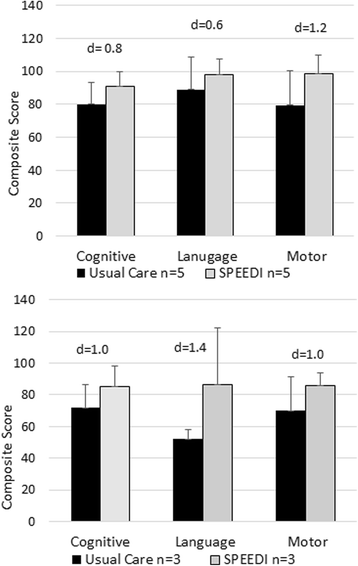Supporting play exploration and early developmental intervention versus usual care to enhance development outcomes during the transition from the neonatal intensive care unit to home: a pilot randomized controlled trial
- PMID: 29426320
- PMCID: PMC5809115
- DOI: 10.1186/s12887-018-1011-4
Supporting play exploration and early developmental intervention versus usual care to enhance development outcomes during the transition from the neonatal intensive care unit to home: a pilot randomized controlled trial
Abstract
Background: While therapy services may start in the Neonatal Intensive Care Unit (NICU) there is often a gap in therapy after discharge. Supporting Play Exploration and Early Development Intervention (SPEEDI) supports parents, helping them build capacity to provide developmentally supportive opportunities starting in the NICU and continuing at home. The purpose of this single blinded randomized pilot clinical trial was to evaluate the initial efficacy of SPEEDI to improve early reaching and exploratory problem solving behaviors.
Methods: Fourteen infants born very preterm or with neonatal brain injury were randomly assigned to SPEEDI or Usual Care. The SPEEDI group participated in 5 collaborative parent, therapist, and infant interventions sessions in the NICU (Phase 1) and 5 at home (Phase 2). Parents provided daily opportunities designed to support the infants emerging motor control and exploratory behaviors. Primary outcome measures were assessed at the end of the intervention, 1 and 3 months after the intervention ended. Reaching was assessed with the infant supported in an infant chair using four 30 s trials. The Early Problem Solving Indicator was used to evaluate the frequency of behaviors during standardized play based assessment. Effect sizes are including for secondary outcomes including the Test of Infant Motor Performance and Bayley Scales of Infant and Toddler Development.
Results: No group differences were found in the duration of toy contact. There was a significant group effect on (F1,8 = 4.04, p = 0.08) early exploratory problem-solving behaviors with infants in the SPEEDI group demonstrating greater exploration with effect sizes of 1.3, 0.6, and 0.9 at the end of the intervention, 1 and 3 months post-intervention.
Conclusions: While further research is needed, this initial efficacy study showed promising results for the ability of SPEEDI to impact early problem solving behaviors at the end of intervention and at least 3 months after the intervention is over. While reaching did not show group differences, a ceiling effect may have contributed to this finding. This single blinded pilot RCT was registered prior to subject enrollment on 5/27/14 at ClinicalTrials.Gov with number NCT02153736.
Conflict of interest statement
Ethics approval and consent to participate
This study was approved by the Human Subjects Board at Virginia Commonwealth University and a parent signed permission for their own and their child’s participation as well as access to their child’s medical records throughout the study period.
Consent for publication
Not Applicable for the body of the manuscript as no individual level data or pictures are in the manuscript.
Competing interests
The authors declare that they have no competing interests.
Publisher’s Note
Springer Nature remains neutral with regard to jurisdictional claims in published maps and institutional affiliations.
Figures




References
-
- Kuban KC, Allred EN, O'Shea TM, Paneth N, Pagano M, Dammann O, Leviton A, Du Plessis A, Westra SJ, Miller CR, et al. Cranial ultrasound lesions in the NICU predict cerebral palsy at age 2 years in children born at extremely low gestational age. J Child Neurol. 2009;24(1):63–72. doi: 10.1177/0883073808321048. - DOI - PMC - PubMed
Publication types
MeSH terms
Associated data
Grants and funding
LinkOut - more resources
Full Text Sources
Other Literature Sources
Medical
Miscellaneous

